Colletotrichum gloeosporioides
Hydrangeas can be lush, carefree plants, but they are also vulnerable to a number of different fungal infections that can sully the leaves – and in some cases, the flowers.
You know that old saying, “There’s a fungus among us?” There is some truth to that.
A fungus called anthracnose can infect a large number of tropical and temperate plants, and it is widespread throughout the world.
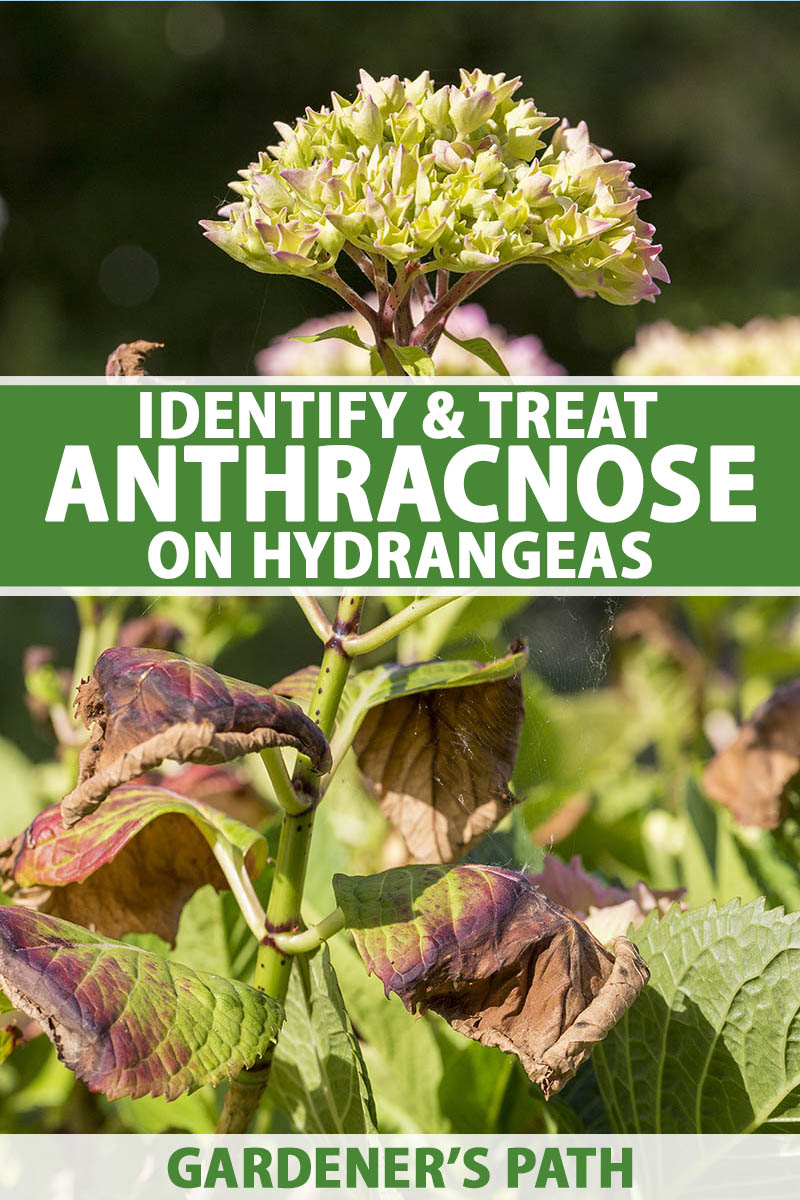
We link to vendors to help you find relevant products. If you buy from one of our links, we may earn a commission.
Unfortunately, hydrangeas can be one of its victims, and bigleaf hydrangeas – Hydrangea macrophylla – are particularly susceptible.
In this article, we’re going to help you to prevent, diagnose, and treat anthracnose in your hydrangeas.
I’ll cover the following topics:
Anthracnose in Hydrangeas
Symptoms
The first indication that your hydrangea is infected with Colletotrichum gloeosporioides will be brown spots on the leaves. Unlike those caused by other pathogens such as Botrytis (aka gray mold), these spots will be circular or slightly irregular. The center of each spot will later turn tan.
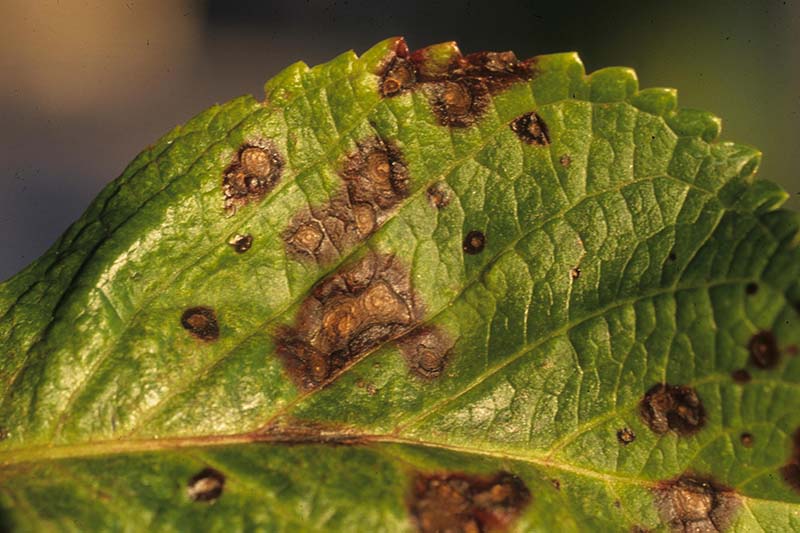
If the spots border a leaf vein, they can develop an angular shape. If conditions are favorable, whole leaves and flower petals can develop large, irregular, dark brown spots that look like blotches.

In addition, the stems can develop sunken areas with raised margins known as cankers. These can be serious, since they can encircle or girdle the branches and stems and eventually kill them.
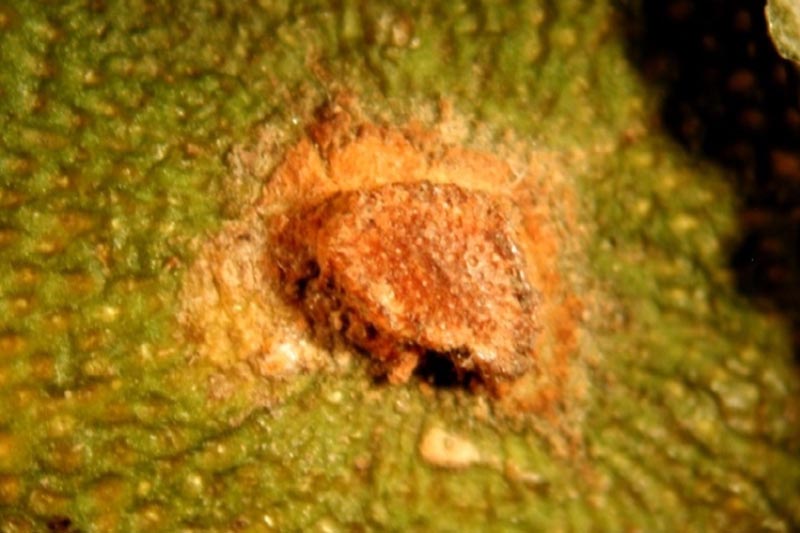
New growth may be crooked or deformed, making the branches look gnarled. A severe infection that has spread throughout the plant and caused deformed stems can kill the hydrangea.
How to Distinguish Anthracnose from Cercospora Leaf Spot
Anthracnose is often confused with Cercospora leaf spot, but there are key differences that you may observe.
While Cercospora also forms circular spots on hydrangea leaves, the lesions start out purple.
As they grow larger, they develop lighter colored centers that look like frog eyes.
When this infection becomes established, whole leaves can turn purple. Keep in mind that this is not to be confused with a phosphorus deficiency either, which may also turn foliage purple.
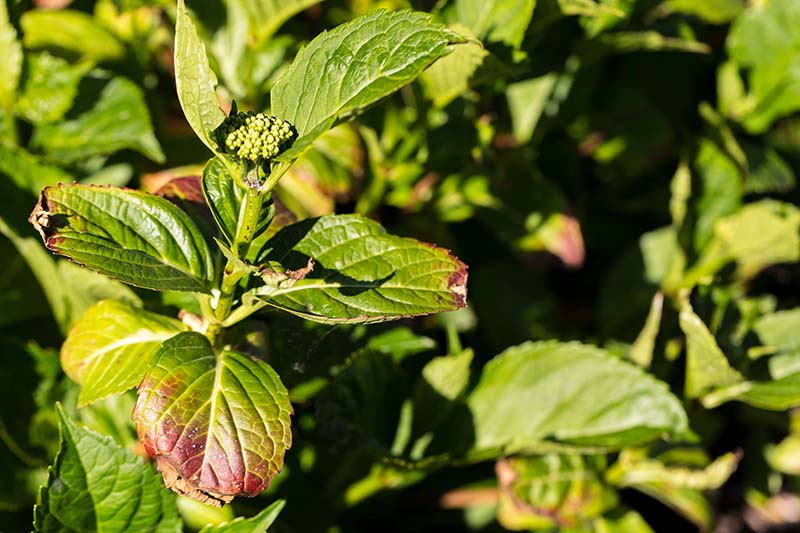
Another key difference is that when your hydrangea is infected with Cercospora, you will see spots on the lower leaves first.
In the case of an anthracnose infection, the lesions can appear simultaneously throughout the top and bottom parts of the plant.
A final notable difference is that Cercospora will not infect the flowers.
Conditions That Favor Infection
Anthracnose is a disease typically seen in hot, wet conditions.
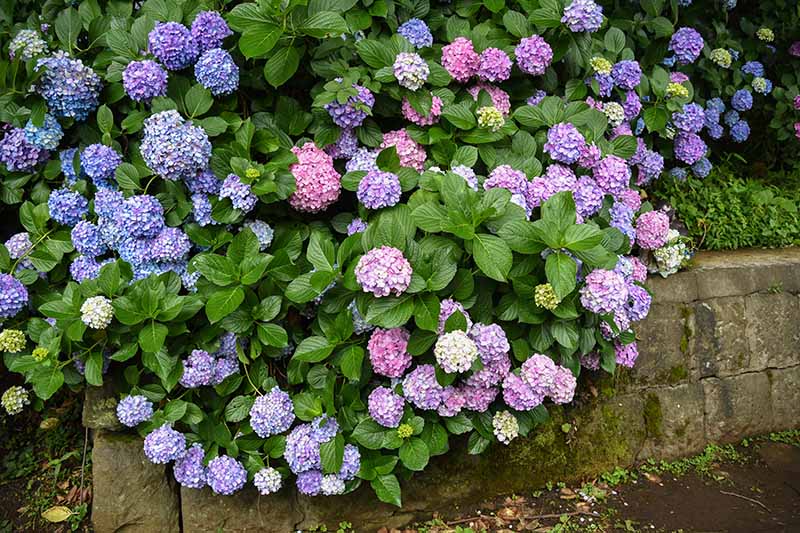
The increased moisture facilitates the spread of the spores, which then infect other areas of the plant. It can also spread to other hydrangeas. The ideal temperatures for infection range from 75 to 90°F.
Several days of wet weather and high temperatures dramatically increase the chances of infection, since the spores spread more quickly.
If there are infected leaves on the plant or leaf debris on the ground beneath it, fruiting bodies will form masses of spores.
All it takes is a bit of rain or overhead watering to spread these spores to other leaves – and even flowers. Prolonged periods of dew and heavy fog also facilitate the spread of this pathogen.
In addition to the masses of spores found in infected tissue on your hydrangeas, this pathogen is widespread in the surrounding environment. Therefore, it is likely to be present in your area and may pose a risk to your hydrangeas whenever the weather is favorable.
Prevention
The good news is that there are some steps you can take to keep this infection from becoming established in your prized plants.
This disease is spread by water, so avoid spraying the flowers and foliage of your plants when you water.
You are much better off watering at the base of the plant. Hydrangeas like a lot of water, but ideally you should water deeply with a soaker hose and then let the soil become dry to the touch in between waterings.
Another tip is avoid over-fertilizing the plants.
Dr. Fulya Baysal-Gurel, et al of Tennessee State University College of Agriculture, Human, and Natural Sciences report that hydrangeas that have been heavily fertilized may be more susceptible to anthracnose.
Management
Once this disease takes hold, it is very difficult to eradicate. But don’t fret! You can take steps to control an infection, or start new plants if you need to.

Since anthracnose can be a difficult disease to treat, when you see the first signs of infection, I recommend taking cuttings from healthy parts of your plant right away.
By taking cuttings that you may root and transplant into the garden, if the disease does end up killing up your hydrangea, you will at least have a few replacements ready to go.
Learn how to propagate hydrangeas from cuttings here.
Next up, let’s take a look at the available options to manage an anthracnose infection.
Pruning and Sanitation
If you see signs of infection, prune out as much of the diseased plant tissue as you can, to prevent the infection from spreading. Trim away any diseased foliage and branches, and gather them for disposal.
Be aware that although hydrangeas can generally tolerate quite a hard pruning, if you have to remove more than 1/3 of the plant, it may not recover.
The fungus can overwinter in plant debris, which can then serve as a source of infection the following spring. Do whatever you can to prevent this as well.
Pick up any fallen leaves or other plant debris on the ground under your hydrangea and dispose of it away from your plants. Preferably, you should place it in a tied bag in the garbage. Do not put infected plant material in your compost pile.
Make sure to disinfect your pruning shears afterwards, with a solution of 10 percent bleach or 70 percent rubbing alcohol. You may also want to consider cleaning your tools between cuts or between plants while you are pruning, to avoid additional unwanted spread.
Fungicides
You may not be able to totally eradicate the infection, but you can prevent it from spreading further by treating the plants with fungicides after pruning.
Spraying with a copper-based fungicide can be effective, such as Bonide Copper Fungicide Dust, available at Arbico Organics.
Copper fungicides are a popular choice, because they are organic. Simply spray or dust your plants according to package instructions.
Another option is chlorothalonil that is non-selective and will treat a range of fungi.
You can find chlorothalonil as Bonide Fung-onil Concentrate, available from Tractor Supply.
Spray your plants with your choice of fungicide every 10-14 days throughout the summer.
If the infection is severe, you can spray more frequently. But be sure to allow enough time for the fungicide to take effect. It might take a week or more to see a difference, so don’t lose hope if you don’t see any changes after a couple of days.
You should also consider spraying any healthy hydrangea plants on your property to protect them from the infection.
If you have problems one year, you should also treat your plants the following season, since the fungi will likely remain in the area.
You might want to buy two types of fungicides and alternate them, so the fungus does not develop resistance to the chemical and gains the ability to spread unchecked!
A Wealth of Spores Can Cause Severe Infections
While anthracnose is typically a problem found in large plantings of hydrangeas in greenhouses or fields, this fungus can also plague home gardeners.
Once it takes hold on a hydrangea plant, the infected leaves or old debris from the previous year can be a source of unending spores in hot, wet weather.
You will have to take aggressive action to save your plants, including pruning out infected tissue and treating the plants with fungicides.
However, with quick action, you have a good shot at limiting the infection.
Have you won a battle with anthracnose? Let us know how you fared in the comments below!
And for more information about growing hydrangeas, you’ll need these guides next:
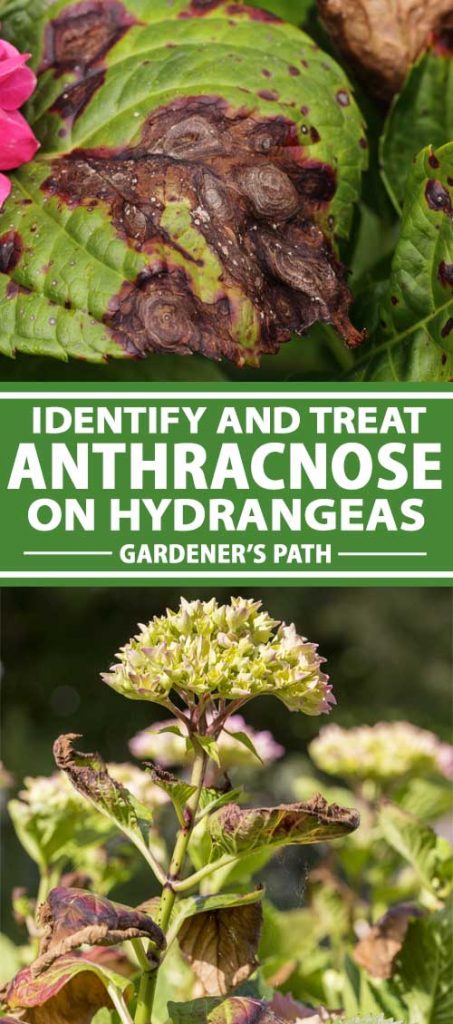
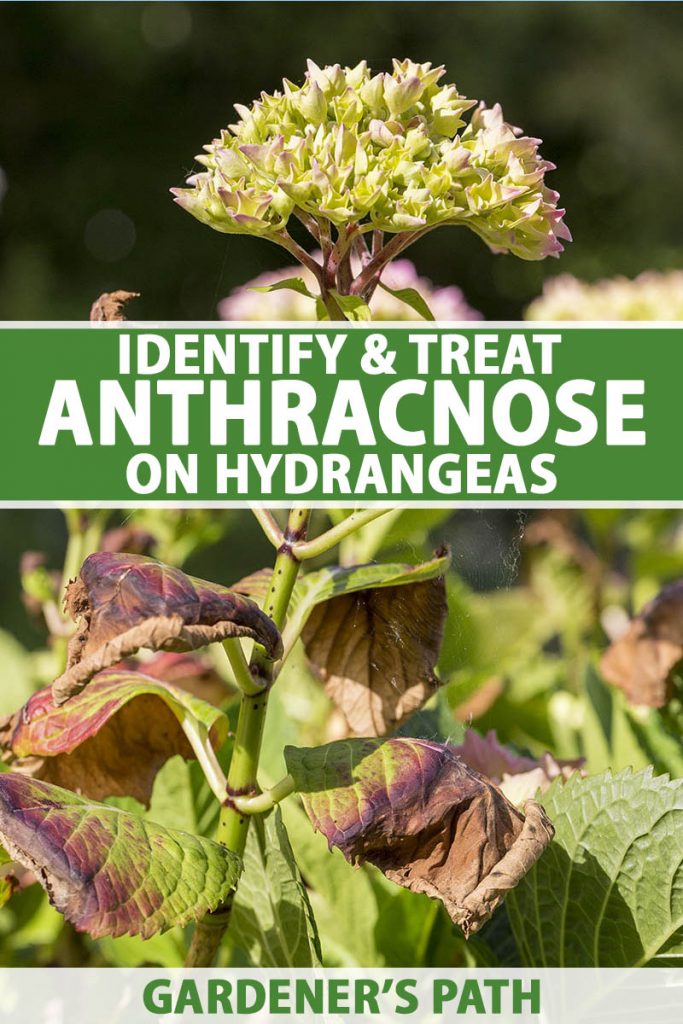
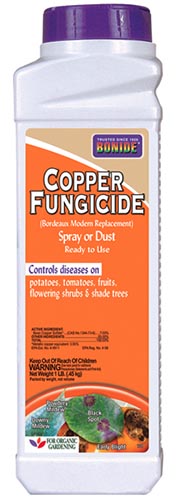

Hi there I am in zone 6b and we have had so much humidity in the past few weeks. It is July 12th and I have just removed all diseased leaves from my 3 hydrangeas and sprayed with a neem oil and fungicide spray. There are new shoots coming out from new wood. Will I get blooms again if I keep the fungicide away or will it take up until next spring to see blooms again? I have removed about 50% of its leaves on one hydrangea and like 1/3 on the other two. Again they have new shoots coming… Read more »
Hi Marcela, That sounds like quite the ordeal! I am glad that new shoots are growing.
I can’t say whether it will bloom this season or not. Panicle and smooth hydrangeas will bloom on new wood, so I think yours should bloom this year if it is one of those types. However, big leaf and oakleaf hydrangeas only bloom on old wood, so if it is one of those, it will not.
Would you know what class it belongs to or what cultivar it is?
please let me know more about oak leaf hydrangeas.
Hi Doris,
Thank you for your question!
My expertise is on diseases, but we have two articles that discuss growing oak leaf hydrangeas:
One is a general article on growing hydrangeas that mentions oak leaf cultivars.
The other is a list of desirable varieties that includes some oak leaf hydrangeas, with some information on how to care for them.
I hope one or both will be helpful to you!
My hydrangeas lower leaves are yellow, but top green and healthy. Also many have a large brown spot in center. How can I remedy this?
Can you share photos, Linda? Do you supply supplementary water, and/or have you been getting a lot of excessively hot weather lately? And is this a large, mature plant? Yellowing at the bottom could possibly indicate issues due to a lack of sun exposure or improper watering, and brown spots can be due to a variety of causes. Would love to help you to get to the bottom of this!
Hi, are you able to confirm if my Hydrangea does in fact have Anthracnose? I may have made the mistake of spraying the leaves with a dish soap/water solution a couple of times over the past week. We have also had a week of rainy weather here as well.
Are the black spots on the surface of leaves as well, or just on the undersides? And have you noted any insect pests as well? This looks like it could potentially be something else, like sooty mold.
Any thoughts on what’s going on with my plant?
I was thinking too much sun initially. It faces the west bc that is my only flower bed. I’m reading on your site that it’s probably diseased?
Hi! I live in Gulfport, Ms and my Phantom Hydrangeas are suffering.. I cannot get the issue under control.
I have been using Neem oil once a week for 5 weeks and no change.
What is causing this and how can I fix it?
I am willing to move them out of pots and in the ground if need be.
Thank you
Are these getting plenty of sun, and does the planter drain well? These look like they could be suffering from powdery mildew, among other possible disease issues. Neem should help, but cultural controls to improve the plants’ growing conditions may be necessary as well.
In addition to using neem, or trying other treatments for fungal disease, you should prune off the diseased plant matter right away, and throw it in the trash to avoid further spread.
Hello! I’m in zone 8b and my hydrangeas are suffering. We are going into winter but what steps (spray, pruning etc) should I do to save them? They are in terrible shape!
The end of the season can be tough on plants, with periods of fluctuating temperatures and wet weather. At this point in the season, I’d hold off on the spray. Remove all of the affected leaves, clean up the area around the plants, and dispose of all affected plant material in the trash. Apply a thick layer of leaf mulch for protection, and to help prevent splashing water from reaching the leaves. With any luck, you’ll see healthy growth in the spring with the return of warm weather. If the fungus continues to spread after new growth appears, try an… Read more »
Excelente, muy práctico
Hi! Hoping you can help me (and my poor hydrangeas) out. At the end of last summer I started to notice black/brown spots forming on the leaves of all three of my hydrangea plants. Also remember the flowers turning brown and drying out too – and it seemed like it happened too early In the season. I’ve noticed new buds starting to grow but it looks like the inner part of nearly all the buds (inside the small leaf part where the tiny green flower clusters usually grow) are black and dried out! I’ve attached photos bc I know my… Read more »
Sorry for the delayed reply, Amanda. This does sound like a fungal disease, either Anthracnose or possibly Cercospora. How are your plants faring now? Have you used any treatments?
Last year some of my hydrangeas became infected with what I think was Anthracnose. The plants actually kept shrinking in size until there was almost nothing left. I did not identify the problem last year but this year did a little research and found out it was most likely Anthracnose. I got Fung-onil and sprayed the plants on two separate occasions. That helped very, very little (if at all). I continued to pick off the diseased leaves; watered only at the base; and got the leaf debris clear away from around the plants. So then I purchased Bonide 811 Copper… Read more »
Hi PCan, It’s hard to say whether Anthracnose might be the problem now that your plants have been cut back. Do you have any photos taken prior to the cutbacks that you can share? If the fungus persists, your best option may be to dig up and dispose of the plants, and solarize the planting area with a thick layer of plastic to kill the fungi. Biofungicides like Arber which contain beneficial Bacillus amyloliquefaciens bacteria may also help.